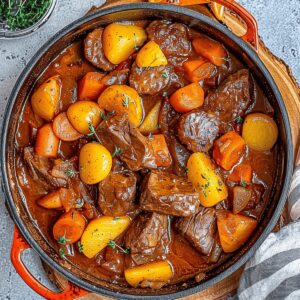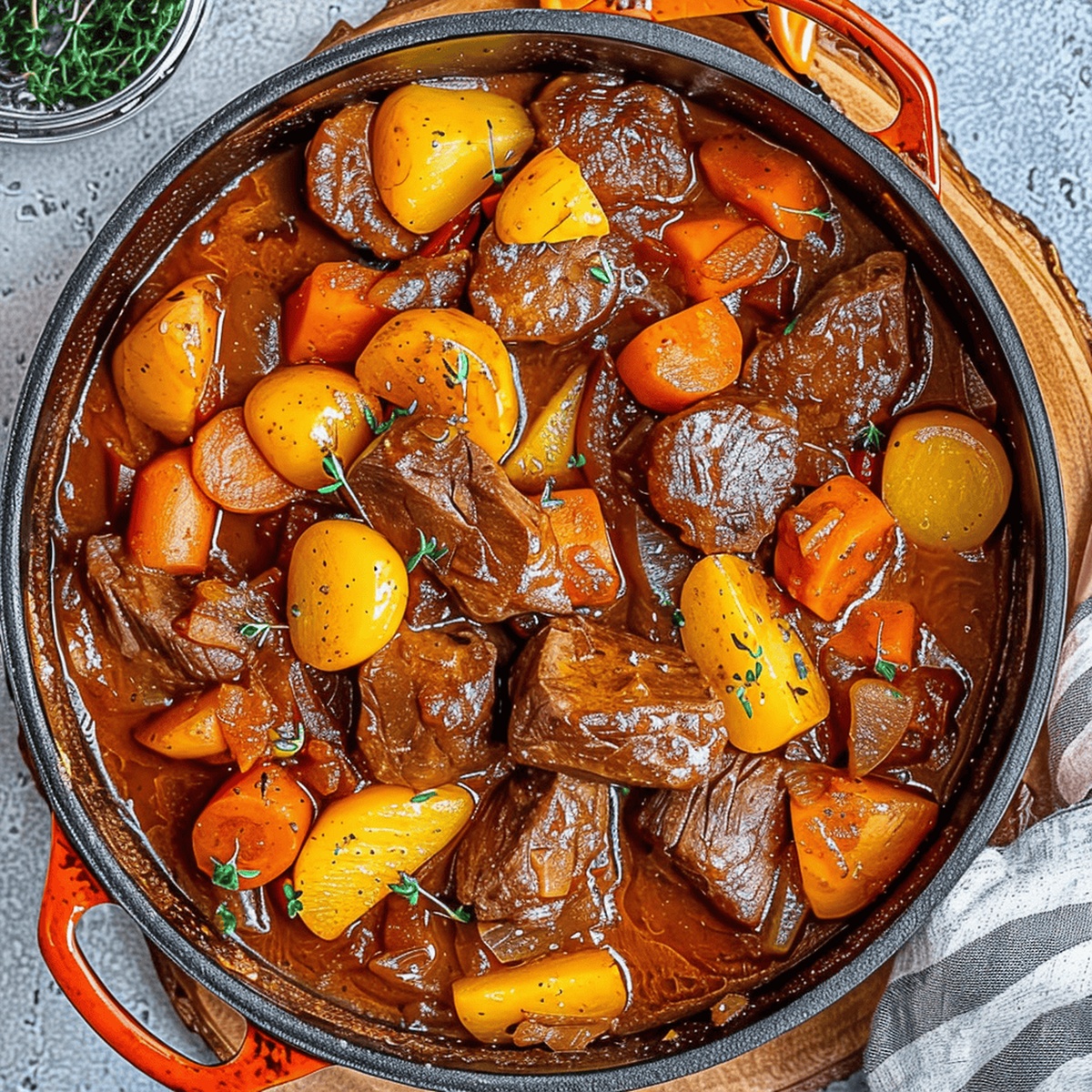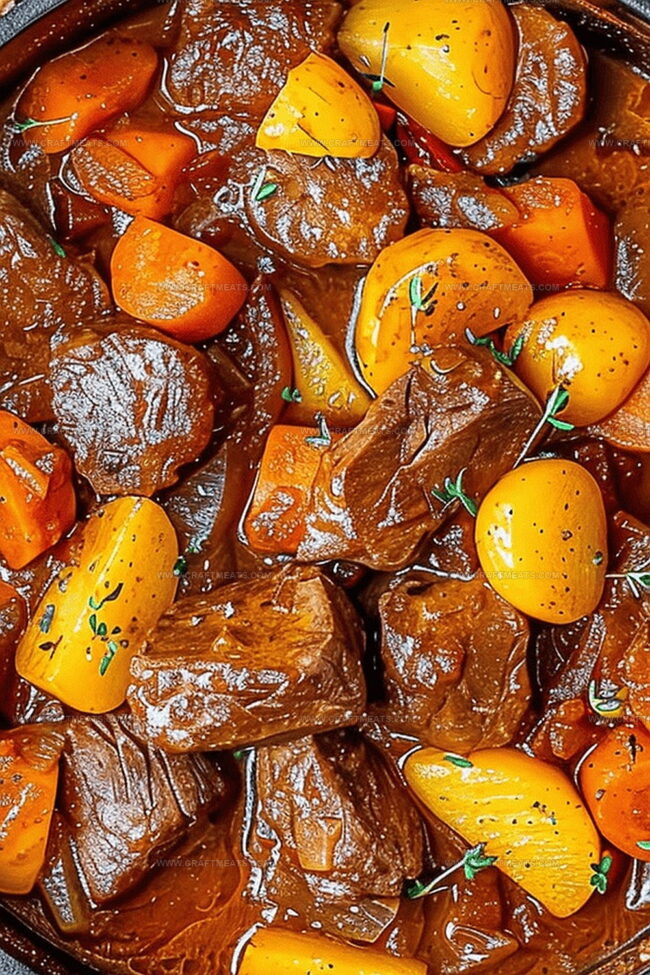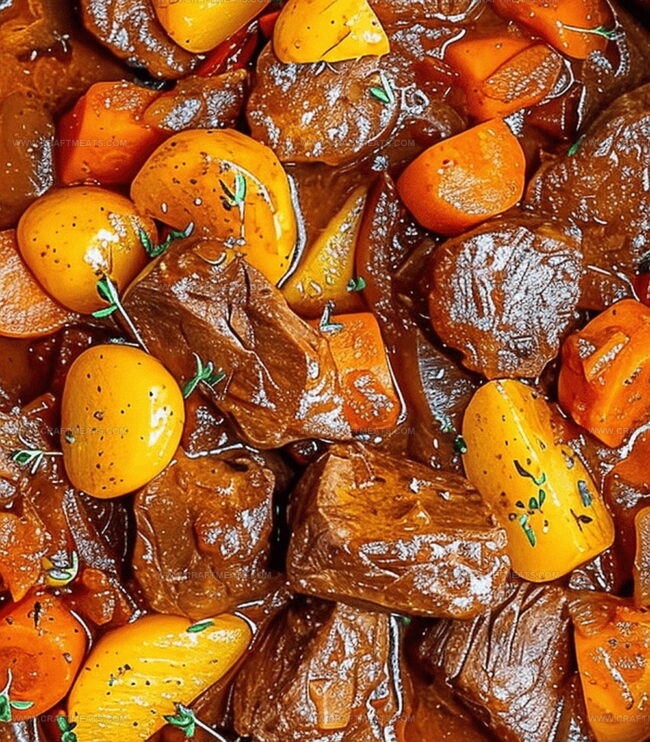Easy Homemade Beef Stew Recipe: Hearty Comfort in a Bowl
Beef stew ranks among the most comforting dishes that instantly warm cold nights and hungry souls.
Rich, hearty flavors meld together in this classic culinary creation that redefines simple ingredients into something extraordinary.
Tender meat slowly simmers alongside robust vegetables, creating a symphony of textures and tastes that dance across your palate.
Generations of home cooks have perfected this beloved meal, passing down techniques that elevate humble ingredients into spectacular comfort food.
Each spoonful tells a story of patience, love, and traditional cooking methods that connect us to our culinary roots.
Robust seasonings and carefully selected ingredients make this stew far more than just another meal—it’s a celebration of home cooking.
Families gather around steaming bowls, sharing stories and creating memories with every delicious bite.
Why Homemade Beef Stew Is the Ultimate Comfort Bowl
What You’ll Need for Classic Homemade Beef Stew
Meat Base:Thickening and Cooking Agents:Aromatic and Flavor Builders:How to Make Beef Stew That’s Rich and Hearty
Step 1: Prep the Cooking Space
Warm up your kitchen oven to a cozy 325°F (165°C). Gather all your cooking tools and ingredients for a delightful beef stew adventure.
Step 2: Season and Coat the Meat
Generously sprinkle salt and pepper over the beef chunks. Dust the meat with flour, ensuring each piece gets a lovely light coating.
Step 3: Sizzle and Brown the Beef
Heat olive oil in a hefty Dutch oven over medium flame. Carefully place beef chunks, creating a golden-brown exterior. Work in batches to avoid overcrowding. Each batch should take 3-4 minutes. Transfer browned pieces to a separate plate.
Step 4: Awaken the Vegetable Flavors
Toss into the same pot:Stir and cook these veggies until they develop a light golden color and release their aromatic essence.
Step 5: Build the Stew Foundation
Add to the pot:Stir everything together, scraping the delicious browned bits from the bottom of the pot.
Step 6: Create the Stew Magic
Bring the mixture to a gentle simmer. Return the browned beef to the pot. Cover the Dutch oven and slide it into the preheated oven.
Step 7: Slow Cook to Perfection
Let the stew simmer in the oven for 2-2.5 hours. The beef should become incredibly tender and melt in your mouth. Remove the bay leaf. Taste and adjust seasoning with additional salt and pepper if needed.
Step 8: Serve and Savor
Ladle the rich, hearty stew into warm bowls.
Tips for Tender Beef and a Deep, Savory Broth
How to Store and Reheat Homemade Beef Stew Like a Pro
What to Serve with Hearty Beef Stew
Beef Stew Variations for Every Season
Print
Homemade Beef Stew Recipe
- Total Time: 2 hours 45 minutes
- Yield: 6 1x
Description
Rich, hearty beef stew brings comfort from classic French countryside kitchens with tender meat simmered in robust red wine sauce. Slow-cooked vegetables and melt-in-your-mouth beef create a soul-warming meal that welcomes you home with deep, complex flavors.
Ingredients
Meat:
- 2 pounds (lbs) beef chuck roast, cut into 2-inch chunks, excess fat removed
Main Vegetables:
- 1 large carrot (or 2 small-medium), cut into 2-inch chunks
- 2 Yukon gold potatoes, diced into 2-inch pieces
- 0.5 yellow onion, chopped large
- 4 garlic cloves, minced
Seasonings and Liquids:
- 1 teaspoon (tsp) kosher salt
- 0.5 teaspoon (tsp) coarsely ground black pepper
- 2 tablespoons (tbsp) gluten-free all-purpose flour (or whole wheat for non-gluten)
- 2 tablespoons (tbsp) olive oil
- 2 cups beef broth
- 0.25 cup tomato paste
- 1 tablespoon (tbsp) Worcestershire sauce
- 1 bay leaf
- 2 teaspoons (tsp) fresh thyme leaves, to garnish
Instructions
- Meticulously coat beef chunks with seasoned flour, ensuring complete coverage for a rich, textured exterior that will enhance flavor development.
- Gradually sear meat in a spacious Dutch oven, creating deep golden-brown crusts that seal in succulent juices and develop complex caramelized undertones.
- Sauté aromatic vegetables until edges transform into a delicate amber hue, releasing their inherent sweet and savory essences into the cooking vessel.
- Incorporate robust liquids and herbaceous seasonings, vigorously scraping accumulated flavor foundations from the pot’s bottom to capture every nuanced taste element.
- Gently combine all ingredients, allowing the meat to nestle comfortably among vegetables and fragrant broth, creating a harmonious culinary composition.
- Transfer the carefully constructed stew into a moderate temperature oven, enabling low and slow transformation that will tenderize meat fibers and meld intricate flavor profiles.
- After substantial braising, carefully extract the bay leaf, which has imparted its subtle botanical notes throughout the cooking process.
- Perform a final seasoning assessment, adjusting salt and pepper to elevate the stew’s depth and complexity before presenting this rustic, comforting dish.
Notes
- Slow-cooking transforms tough beef chunks into melt-in-your-mouth tender bites through patient braising in the oven.
- Layering flavors starts with browning meat, creating a rich caramelized foundation that deepens the stew’s overall taste profile.
- Worcestershire sauce and tomato paste add unexpected depth, bringing complexity and umami to this classic comfort dish.
- Prep Time: 15 minutes
- Cook Time: 2 hours 30 minutes
- Category: Dinner
- Method: Slow Cooking
- Cuisine: American
Nutrition
- Serving Size: 6
- Calories: 360
- Sugar: 4 g
- Sodium: 600 mg
- Fat: 18 g
- Saturated Fat: 5 g
- Unsaturated Fat: 10 g
- Trans Fat: 0 g
- Carbohydrates: 24 g
- Fiber: 3 g
- Protein: 27 g
- Cholesterol: 90 mg




Isabella Rossi
Founder & Culinary Content Creator
Expertise
Recipe Development, Traditional Irish and European Cuisines, Food Styling and Photography, Culinary Education
Education
Dublin Institute of Technology (DIT) – School of Culinary Arts and Food Technology
Ballymaloe Cookery School
Liam is the voice behind many of Craft Meats’ most flavorful features. With roots in Dublin’s smoky barbecue scene and a culinary degree from the Dublin Institute of Technology, he brings time-tested cooking techniques to life.
His training at Ballymaloe Cookery School sharpened his farm-to-table approach, giving him a deep respect for every ingredient he writes about.
He’s not about overcomplicating the process, just helping you cook meat that’s worth talking about. When he’s not writing or grilling, he’s out foraging or nerding out on regional spice blends to add to his next recipe.